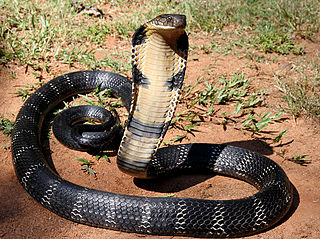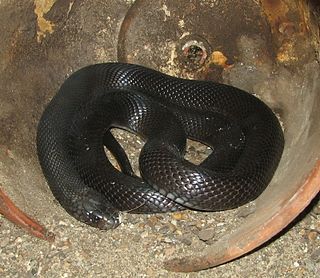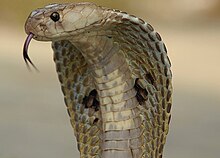
The king cobra is a species complex of snakes endemic to Asia. With an average of 3.18 to 4 m and a record length of 5.85 m (19.2 ft), it is the world's longest venomous snake and among the heaviest. Under the genus Ophiophagus, it is not phylogenetically a true cobra despite its common name and some resemblance. Spanning from the Indian Subcontinent through Southeastern Asia to Southern China, the king cobra is widely distributed albeit not commonly seen.

Elapidae is a family of snakes characterized by their permanently erect fangs at the front of the mouth. Most elapids are venomous, with the exception of the genus Emydocephalus. Many members of this family exhibit a threat display of rearing upwards while spreading out a neck flap. Elapids are endemic to tropical and subtropical regions around the world, with terrestrial forms in Asia, Australia, Africa, and the Americas and marine forms in the Pacific and Indian Oceans. Members of the family have a wide range of sizes, from the 18 cm (7.1 in) white-lipped snake to the 5.85 m king cobra. Most species have neurotoxic venom that is channeled by their hollow fangs, and some may contain other toxic components in varying proportions. The family includes 55 genera with around 360 species and over 170 subspecies.

Aspidelaps is a genus of venomous elapid snakes endemic to Africa. Species in the genus Aspidelaps are commonly called shield-nosed cobras, African coral snakes or coral cobras after their cobra hoods and enlarged rostral (nose) scales. However, the hood is not nearly as well developed in Aspidelaps as it is in the true cobras of the genus Naja.

The Indian cobra, also known commonly as the spectacled cobra, Asian cobra, or binocellate cobra, is a species of cobra, a venomous snake in the family Elapidae. The species is native to the Indian subcontinent, and is a member of the "big four" species that are responsible for the most snakebite cases in India.

The monocled cobra, also called monocellate cobra and Indian spitting cobra, is a venomous cobra species widespread across South and Southeast Asia and listed as Least Concern on the IUCN Red List.

Walterinnesia aegyptia, also known as the desert cobra or desert black snake, is a species of venomous snakes in the family Elapidae that is native to the Middle East. The specific epithet aegyptia refers to part of its geographic range.

Walterinnesia is a genus of venomous snakes in the family Elapidae. The genus contains two species, known commonly as desert black snakes or black desert cobras, which are endemic to the Middle East. The generic name Walterinnesia honours Walter Francis Innes Bey (1858–1937), who was a physician and zoologist in Egypt.

The Mozambique spitting cobra is a highly venomous species of spitting cobra native to Africa. It is largely found in Angola, Botswana, Malawi, Mozambique, Namibia, South Africa, Tanzania, Zambia, and Zimbabwe.

The Egyptian cobra is one of the most venomous species of snakes in North Africa, and has bitten many humans. It averages roughly 1.4 metres (4.6 ft) in length; the longest specimen recorded so far measured 2.59 metres (8.5 ft).
Pseudohaje is a genus of venomous African elapid snakes, commonly called tree cobras or forest cobras because of their arboreal lifestyle. Their ability to produce a hood is limited to a slight flattening of the neck.

The Indochinese spitting cobra also called the Thai spitting cobra, black and white spitting cobra, Siamese spitting cobra, is a species of spitting cobra found in Southeast Asia.

Goldie's tree cobra, also known commonly as the African tree cobra and as Gold's tree cobra, is a species of venomous tree cobra in the family Elapidae. The species is native to Central and Western Africa. This species is one of the two tree cobras in Africa, the other being the black tree cobra. Goldie's tree cobra is one of the most venomous snakes and creatures in Africa.

The forest cobra, also commonly called the black cobra and the black and white-lipped cobra, is a species of highly venomous snake in the family Elapidae. The species is native to Africa, mostly the central and western parts of the continent. It is the largest true cobra species with a record length of 3.2 metres.

Naja nigricincta is a species of spitting cobra in the genus Naja, belonging to the family Elapidae. The species is native to the deserts and drier regions of southern Africa. The species is largely nocturnal, and is often found while crossing roads at night. There are two recognized subspecies.

Naja christyi, commonly known as the Congo water cobra or Christy's water cobra, is a species of venomous snakes belonging to the family Elapidae. The species is native to Sub-Saharan Africa.

Aspidelaps lubricus, commonly known as the Cape coral snake, Cape coral cobra or coral shield cobra, is a species of venomous snake in the family Elapidae. The species is endemic to southern Africa.

Anchieta's cobra, sometimes referred to as the Angolan cobra, is a species of venomous snake in the family Elapidae. The species is native to Southern Africa.

The Andaman cobra or Andaman spitting cobra is a species of cobra endemic to the Andaman Islands of India. The name of this cobra comes from the Islands itself. The species has a very potent venom, and is capable of “spitting”, although this defensive behavior is very rare and the aim is poor and not as efficient as “true spitting cobras”.

The shield-nosed cobra, or eastern shield-nose snake, is a venomous snake of the family Elapidae.

















